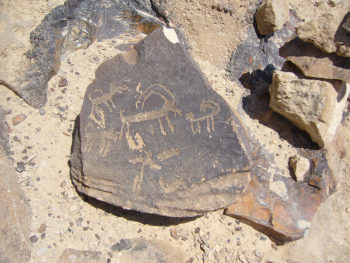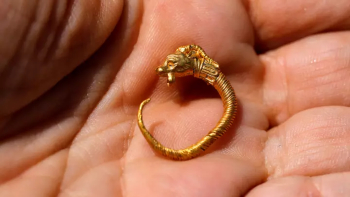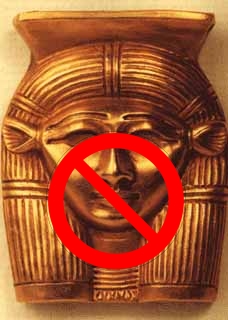
 |

 |
Then, as the culmination of His speaking![]() on Har Sin•aiꞋ, He inspired Mōsh•ëhꞋ to etch
on Har Sin•aiꞋ, He inspired Mōsh•ëhꞋ to etch![]() two lūkh•ōtꞋ of the Eid•ūtꞋ; lūkh•ōtꞋ of stone written by the finger
two lūkh•ōtꞋ of the Eid•ūtꞋ; lūkh•ōtꞋ of stone written by the finger![]() of ël•ōh•imꞋ.
of ël•ōh•imꞋ.
 |
When the am saw that Mōsh•ëhꞋ was overdue to descend from the Har, the am congregated about A•ha•rōnꞋ, telling him, “Stand-up! Make us an ël•ōh•imꞋ that will parade in front of us, because this Mōsh•ëhꞋ guy, the ish who brought us up from ËrꞋëtz Mi•tzᵊraꞋyim, we don’t know what’s happened to him.”
Then A•ha•rōnꞋ told them, “Unfasten the gold earrings of your wives, sons and daughters and bring the earrings to me.”
So all of the am unfastened their gold earrings and brought them to A•ha•rōnꞋ.
| Etching-stylus from c70CE Rome (found in London, photo MOLA (Museum of London Archaeology |
Having taken the gold earrings from their hands, he sand-casted a gold calf mask,![]() then used a stylus to etch its features.
then used a stylus to etch its features.
Then they said, “This is your ël•ōh•imꞋ, Yi•sᵊr•â•eilꞋ, that brought you up from ËrꞋëtz Mi•tzᵊraꞋyim!”
Seeing this, A•ha•rōnꞋ built a mi•zᵊbeiꞋakh before it. Then A•ha•rōnꞋ called out, saying, “Tomorrow will be a Khag to é‑‑ä!”
The following morning, they stood-up in the pre-dawn darkness and sacrificed ōl•ōtꞋ, brought shᵊlâm•imꞋ and sat down to eat and drink. Then they got up to debauch.![]()
But Mōsh•ëhꞋ perceived![]() é‑‑ä speaking to him:
é‑‑ä speaking to him:
 |
“Get down there quick! For the am has reverted to its perverted idolatrous acculturation,
brought out of ËrꞋëtz Mi•tzᵊraꞋyim. How quickly they have strayed from the DërꞋëkh I commanded them! They made for themselves a calf mask,
prostrated before it and sacrificed to it, saying, “This is your
ël•ōh•imꞋ, Yi•sᵊr•â•eilꞋ, which brought you
up from ËrꞋëtz Mi•tzᵊraꞋyim.””
Furthur, Mōsh•ëhꞋ perceived![]() é‑‑ä telling him,
é‑‑ä telling him,
“I’ve seen this am. Look, they’re a stiff-necked am. So sit back and watch while I vent rage upon them and incinerate
them! Then I will make you
a great goy.”
But Mōsh•ëhꞋ felt sick about it before the Face of é‑‑ä his ël•ōh•imꞋ. So he![]() asked, “Why will é‑‑ä vent a ragestorm upon His am whom you
asked, “Why will é‑‑ä vent a ragestorm upon His am whom you![]() have brought forth from ËrꞋëtz Mi•tzᵊraꞋyim? Why should the Mi•tzᵊraꞋyim be enabled to say, ‘Their é‑‑ä was wrong!!! He ended-up bringing them forth only to get them killed in the mountains and eradicated from the face of hâ-a•dâm•âhꞋ.’ Turn from your
have brought forth from ËrꞋëtz Mi•tzᵊraꞋyim? Why should the Mi•tzᵊraꞋyim be enabled to say, ‘Their é‑‑ä was wrong!!! He ended-up bringing them forth only to get them killed in the mountains and eradicated from the face of hâ-a•dâm•âhꞋ.’ Turn from your![]() ragestorm and show compassion for Your
ragestorm and show compassion for Your![]() am concerning the wrongdoing. Remember Your
am concerning the wrongdoing. Remember Your![]() workers — Avᵊrâ•hâmꞋ, Yi•tzᵊkhâqꞋ and Ya•a•qōvꞋ, to whom You
workers — Avᵊrâ•hâmꞋ, Yi•tzᵊkhâqꞋ and Ya•a•qōvꞋ, to whom You![]() swore within Yourself
swore within Yourself![]() declaring to them:
declaring to them:
“I will proliferate your
seed like the stars of the shâ•maꞋyim, and all of this ârꞋëtz—as I’ve said—I will give to your
seed, and they shall inherit it lᵊ-o•lâmꞋ.”
So é‑‑ä relented concerning the wrongdoing of His am; i.e. what He had spoken to do to His am.
Thus, Mōsh•ëhꞋ turned and descended from the Har with the two stone lūkh•ōtꞋ of the Eid•ūtꞋ in his hand; lūkh•ōtꞋ that were etched front and back, etched on the one side and the other.![]() The lūkh•ōtꞋ were the Ma•a•sëhꞋ of ël•ōh•imꞋ; and the Missive
The lūkh•ōtꞋ were the Ma•a•sëhꞋ of ël•ōh•imꞋ; and the Missive![]() was the Missive
was the Missive![]() of ël•ōh•imꞋ, etched upon the stone lūkh•ōtꞋ.
of ël•ōh•imꞋ, etched upon the stone lūkh•ōtꞋ.
When Yᵊhō•shūꞋa heard the sound of the am whooping and said to Mōsh•ëhꞋ, “Sounds like there’s a war in the camp.”
”The tumultuous sound of responses I’m hearing,” Mōsh•ëhꞋ replied, “are neither the sound of a war-whoop responses nor the sound of agony responses.”
So it was, that when he came near the camp, he saw the calf and the dancing. Mōsh•ëhꞋ vented a ragestorm! He threw the stone lūkh•ōtꞋ down, breaking them, at the foot of the har. Then he took the calf that they had made and he melted it down in the fire. After it cooled, he collected the bullion, ground it into powder and strewed it on the pool of their drinking water so that Bᵊn•eiꞋ-Yi•sᵊrâ•eilꞋ would be reminded of their shame every day when they fetched their daily drinking water.
Then Mōsh•ëhꞋ oppugned A•ha•rōnꞋ: “What did this am do to you to force you to bring such a great misstep-punishment upon them?”
”Don’t vent a ragestorm, Mōsh•ëhꞋ, a•don•iꞋ!” A•ha•rōnꞋ replied. “You know the am, that it’s innately râ. Well, they told me to make them an ël•ōh•imꞋ that shall parade in front of us; because this Mōsh•ëhꞋ guy, the ish who brought us up from ËrꞋëtz Mi•tzᵊraꞋyim, we don’t know what happened to him.”
”So I told them, ‘Whoever has gold, unfasten it and give it to me.’ Then I threw it in the fire and this calf-face form emerged.”![]()
Now Mōsh•ëhꞋ saw how the am had gone wild, for A•ha•rōnꞋ had enticed them to go wild—i.e. their standing-up to make themselves an infamy. So Mōsh•ëhꞋ stood in the shaꞋar of the camp and said, “Whoever belongs to é‑‑ä, Over here!” And all of Bᵊn•eiꞋ-Lei•wiꞋ gathered to him, leaving only the unrepentant wild idolaters in the camp.

Optional parental preparation:
What is sand-casting (pouring molten metal into a sand mold)?
What does oppugn mean?
31.18 Etching — ”Petroglyphs are common on rocks like these because their surfaces lend themselves well to drawing. Limestone boulders that have a high iron content develop a rust-like patina on the outside that makes them darker than the surrounding rocks. The dark layer is thin, though, and can be easily scratched with another stone to reveal bright white stone beneath… Experts… can verify the drawings’ age to some extent by the color of the scratched lines. Newly-etched markings are bright white, but over time, the white lines start to oxidize just like the outside of the rock, and eventually turn brownish or rust-colored.”![]()
![]()
![]()
 |
The annual late-summer ancient Egyptian idol-festival “dates from the Old Kingdom and was among the most anticipated. The cult of [Hât-HōrꞋ] was extremely popular and, … the celebration was well-attended wherever it was held. … [P]articipants were encouraged to over-indulge in alcohol while engaging in singing and dancing in honor of the goddess. There may also have been a sexual component to the celebration…” ![]()
“[Hât-HōrꞋ] was the incarnation of dance and sexuality and was given the epithet “Hand of God” (refering to the act of masturbation) and “Lady of the Vulva”.”![]()
Participants of this sacred festival, held at the beginning of the inundation of the Nile that brought the annual revival of life, engage in sex orgies as a way of celebrating [Hât-HōrꞋ], a goddess of love and fertility of the land.
”As a goddess who transcended life and death, [Hât-HōrꞋ] was widely worshipped and came to be idenified with a deity known as The Distant Goddess… in The Book of the Heavenly Cow… When the Distant Goddess eludes Râ's control, a god is sent forth by Râ to find his daughter and bring her home and, when this happens, she brings with her the inundation of the Nile River which overflowed its banks and brought life to the people. Before she released the life-giving waters, however, she had to be placated and shown appreciation. Geraldine Pinch writes:
“When the Distant
Goddessreturned, she brought the inundation with her, but she had to be pacified with music, dancing, feasting, and drunkenness. This was the mythical justification for the wild, ecstatic elements in [Hât-HōrꞋ]'s cult. It was proper for the whole of creation to rejoice when [Hât-HōrꞋ] appeared again in all her radiant beauty and joined forces with her father.”
The ancient Greeks equated [Hât-HōrꞋ] with their own Aphrodite, the Olympian goddess of love, beauty, sexual pleasure, and fertility.
![]()
![]()
32.10 “eat” — àÈëÇì, popularly rendered “consumed” when it’s used in the sense of consuming rage; to “consume completely, like by a fire”; burn-up completely, eradicate; i.e. incinerate. ![]()
![]()
32.11. “His” refers to é‑‑ä, so who is “you”![]() ? And who else would then be the questioner-narrater? — One might suggest that Mōsh•ëhꞋ was debating this question in his mind. But, then who would be the “you” — in addition to “His” — who brought Yi•sᵊr•â•eilꞋ out of Mi•tzᵊraꞋyim? It seems most likely that the questioner-narrater was Yᵊhō•shūꞋa (Bin-Nūn, of course) conferring with Mōsh•ëhꞋ to decide the proper response.
? And who else would then be the questioner-narrater? — One might suggest that Mōsh•ëhꞋ was debating this question in his mind. But, then who would be the “you” — in addition to “His” — who brought Yi•sᵊr•â•eilꞋ out of Mi•tzᵊraꞋyim? It seems most likely that the questioner-narrater was Yᵊhō•shūꞋa (Bin-Nūn, of course) conferring with Mōsh•ëhꞋ to decide the proper response. ![]()
![]()
Questions you might anticipate that your child might raise and be prepared to discuss:
What does it mean to prostrate oneself?
What does acculturation mean? Assimilation?
What does it mean to be stiff-necked (obstinate, stubborn)?
What does “vent a ragestorm” mean? (I.e. explode in a monumental rage)
What does it mean to relent?
What is the “foot” of a mountain?
What is a stylus? Etching?
What does stray mean?
What is (gold) bullion?
What does innate mean?
What does the verb strew mean?
What does infamy mean?
![]()
 |
 |